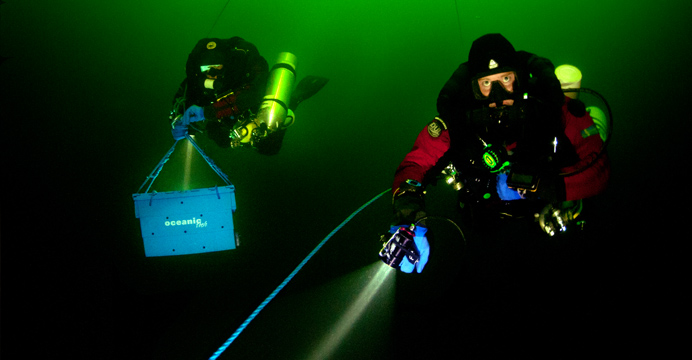
På 30-300 meters djup används gasblandningar med högre andelar helium som Trimix, Heliair och Heliox
With the course set for the bottom of the Baltic Sea.
Stefan Hogeborn, one of Sweden’s most qualified divers, talks about what it’s like having the seabed as your workplace and about discovering the wreck S/S Astrid.
Stefan Hogeborn works as an instructor for the diving company OceanicTech, while also being involved in expeditions with the shipwreck searching team Ocean X Team. A true dream job as Stefan describes it, as he has been given the opportunity to utilise the synergy effects that exist between photography and diving.
Stefan has been working as a photographer for 20 years on various underwater expeditions all around the world. In particular caves, mines and deeplying wrecks, that is locations with extremely little light, have become Stefan’s speciality. His photographic exploits include the newly found Soviet submarine S2 and his pictures have been published in media all across the world. For Stefan, working as a diver means spending a great number of days per year out at sea and dives take place in all kinds of weather conditions, even in icy waters. That wreck diving is dangerous work is not something Stefan agrees with. It’s all about routines, procedures and the right preparation. With training and experience you learn to dive safely and also to know how to react in case something should go wrong. This way, diving becomes a safe and incredibly cool experience, Stefan assures us.
Unplanned discovery
In the summer of 2012, Stefan was out at sea with the shipwreck searching team Ocean X Team outside the harbour at Raumo on the coast of Finland. The Ocean Xteam was really looking to investigate a mystical circle on the bed of the Baltic Sea, but during the expedition’s second trip they ran into technical problems and instead the expedition ship Ancylus set course for an unknown object nearby. The team’s sonar scanners soon revealed that their decision was a lucky throw of the dice. Before them on the seabed rested an unknown shipwreck. Together with his diving colleagues, Stefan made his way down towards the wreck which was resting at a depth of some 80 metres.
As usual, the diving gear included a dry suit and cylinders with different gas mixtures. The gas mixtures are used to allow you to keep warm in the cold water and to avoid the two hazards of diving: the bends and oxygen intoxication. Before descending, Stefan made sure that his underwater camera was working. When diving at a depth of 80 metres, you need to descend slowly to allow the body to adjust to the increasing pressure. As oxygen becomes toxic to the body at depths of just 30 metres, other types of gas mixtures such as argon and trimix must also be used. When they got near the seabed, Stefan’s colleague signalled with his torch when the wreck came into sight. Stefan made his way past an anchor that was lying by the side of the wreck and could feel his heart race when he saw the figurehead. That was truly a cool discovery, Stefan recalls. The woman had a fantastic laurel wreath coated in gold.
Valuable cargo
The wreck that the team had found turned out to be the luxury yacht s/s Astrid, which on its journey between Stockholm and Finnish Raumo was sunk by the German submarine U22 on 11 November 1916. During the First World War, the Germans sank several ships in the area as they had set up a trade blockade to stop the import of luxury products to Russia. And sure enough, Stefan and his team found a number of wooden crates in the wreck’s cargo hold which they pulled up to the ship.
When they prised open the lock on the wooden crates they found 21 bottles of wine. “This was even better as this was not even the wreck we had initially been looking for”, says Stefan. Some of the bottles were analysed in London and there it was found that they were 100-year-old bottles containing Madeira and port wine. Of the 21 bottles that were retrieved, 7 turned out to be drinkable and had also maintained their high quality. In due time, the bottles will be put up for auction with one bottle expected to fetch around SEK150,000 to 200,000.
“Astrid was one of my coolest discoveries”, says Stefan. We usually find between three and five wrecks every year, but she was special not just because of the bottles we found but also because the wreck was still intact. The masts were still in place and the figurehead… Well, it was the most beautiful one I’ve seen.
Text: Max Sihvonen, Photo: Stefan Hogeborn
